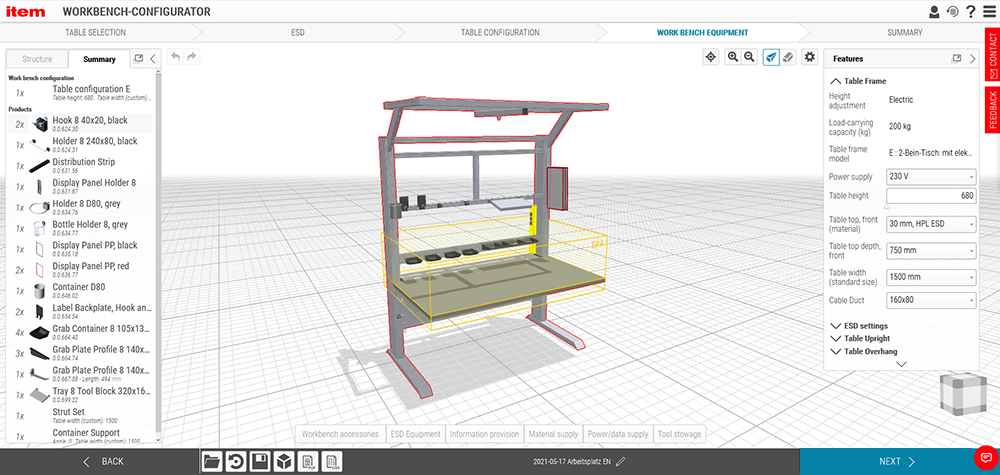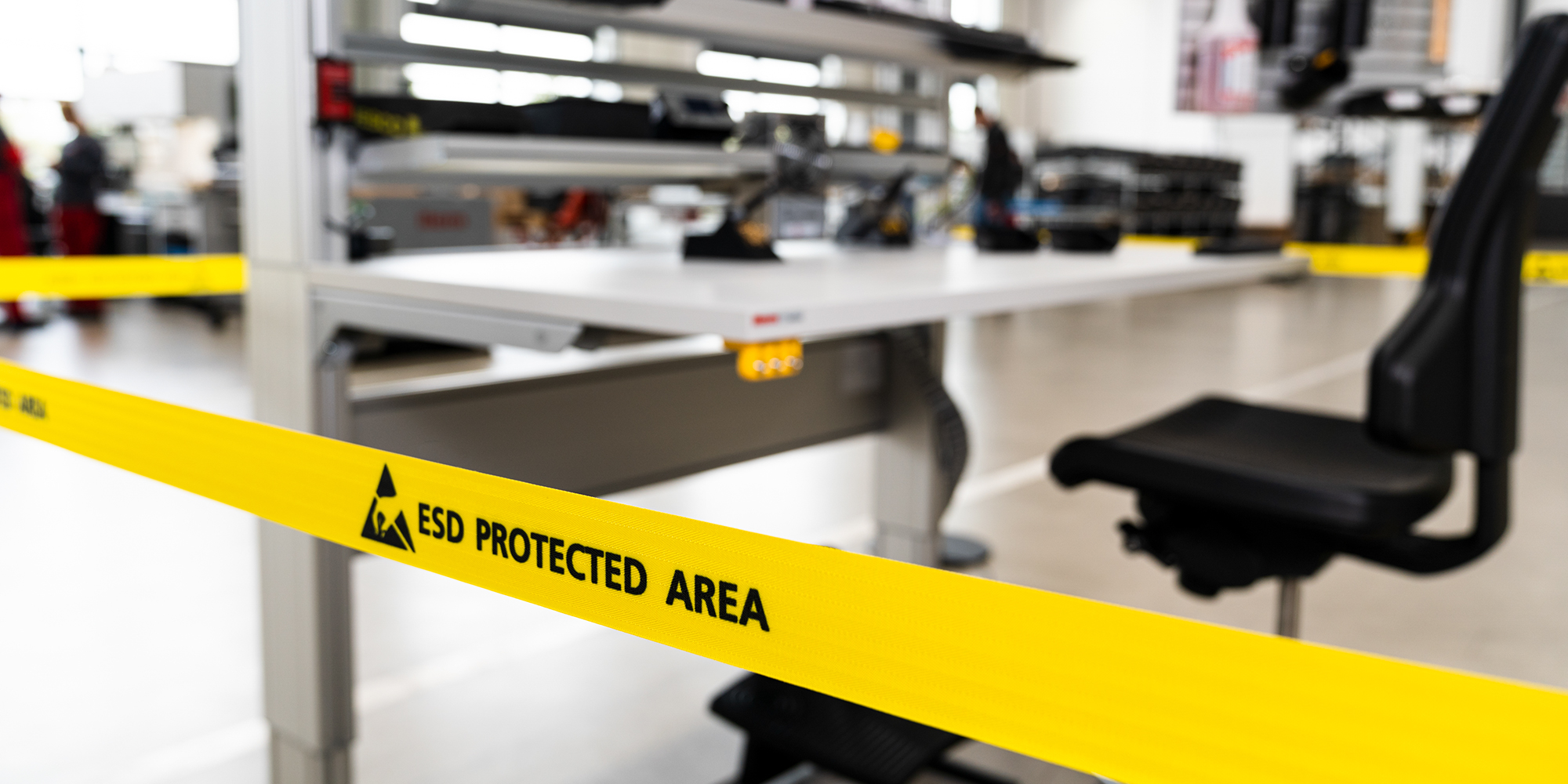Standard DIN EN 61340-5-1, which lays out the fundamentals of ESD protection, stipulates the need for an appropriately designed Electrostatic Protected Area (EPA).
Electronic components can only be handled and assembled safely in an EPA, where all materials are electrostatically dissipative and grounded to the same potential. Whether they are part of a larger EPA or form a smaller EPA limited to the bench itself, there is no avoiding specialised ESD work benches. An ESD work bench has a volume-conductive table top. The volume conductivity of an ESD table top is achieved by using a single piece of chipboard that has had graphite powder incorporated into it during a complex production process. The coating layer of the ESD table top is also completely volume-conductive because it has carbon-based particles mixed through it. ESD Table Mats are also available, though these are only suitable for use where components are being handled in a small area. In addition, employees working at an ESD bench are equipped with an ESD Wristband for personal grounding. Like all ESD protection elements, this wristband must be grounded – a connection that is created via the table frame. Work benches from item have aluminium frames, meaning they are fundamentally conductive – the same applies to the fasteners used. But what are the other factors to be considered when designing an ESD work bench?

Requirements for an EPA
From access controls and aspects such as flooring, the work bench and chair all the way to air conditioning – we have summarised all the key elements of an EPA in one place for you.
GET THE WHITE PAPER
There are many aspects to thorough ESD protection at the work bench
To ensure overarching safety when using an ESD work bench, the discharge resistance and surface resistance limits specified in IEC 61340 must be complied with. This is where the work and storage surfaces play a key role, as they need to meet a minimum requirement as well as satisfying the stipulated maximum resistance. This ensures potential charges are not dissipated too quickly, and thus prevents damage. Exactly which ESD safety measures are needed on the ESD table depends on the specific tasks involved. If tools are required, these must be high-quality ESD-safe tools that can be stowed appropriately on the ESD work bench. This ensures any charges that occur are always dissipated. The greatest care should also be taken with movable components such as pivot arms, as charges can build up quickly due to friction. It is also important that articulated elements such as these use a joint that is not insulating. Pivot Arms from item are therefore designed in such a way that they always have metallic contact.
item customers receive a special ESD record that proves their ESD work bench has been checked at the relevant ESD measuring points.
It is an absolute must that the ESD protection of every single ESD work bench be measured before delivery. Nevertheless, this particular aspect does not always receive the attention it requires. item customers, on the other hand, receive a special ESD record that proves their ESD work bench has been checked at the relevant ESD measuring points. These include both standard points (the ESD table top and storage surfaces) and additional points that require special attention and are defined in consultation with the customer. This ensures the solution delivered is properly designed with the correct discharge resistance. ESD table components should be checked regularly once on site. If the work bench is cleaned incorrectly or not at all, this can compromise the electrostatic dissipation, even though this cannot be seen with the naked eye.
ESD work bench design – much more than just using an ESD table top
When designing an ESD work bench, it is vital to keep an eye on the big picture. The first question to consider is where the key points of the production process are. To this end, it is a good idea to imagine the relevant ESDS (electrostatic discharge sensitive device) – that is to say, a component that could be damaged by uncontrolled electrostatic discharge – and follow it on its journey through your company from start to finish in your mind’s eye. If there is a manual work step at a work bench, then this must naturally be carried out in an EPA. This means the work bench must be located in an EPA and, more importantly, the bench itself should be designed to be ESD-safe. In principle, the floor of an EPA must be dissipative and connected to the earth at a sufficient number of points that there is adequate discharge resistance on every part of the floor. In smaller EPAs, carefully positioned mats will suffice, while larger areas need complete coverage with electrostatically dissipative flooring. Everything works towards the aim of allowing the different charge potentials to discharge in a controlled way so they are equalised.
The working surface of the ESD work bench and the material storage surfaces should always have an uninterrupted connection with the ESD earthing point.
In the context of ESD protection, “earthing” or “grounding” means that electrostatic charges are dissipated into the ground. If individual elements are grounded, they exhibit the same electrostatic potential. This prevents electrostatic discharges from occurring due to differences of electrical potential. There are two ways of achieving grounding. Firstly, separate earthing leads can be laid. Alternatively, existing infrastructure such as the protective earthing in the power supply can be used. It all depends on the task at hand and the space available. In addition, it must be determined where the earth bonding point (also called the ESD earthing point) – the connection between the ESD work bench and the ground – is to be. Although this is occasionally achieved via the floor, this is highly inadvisable, as it makes it hard to control the contact resistance properly. For example, the ESD floor might contain contaminants, or the movement of the ESD work bench could cause scratches that damage the coating of the floor. Instead, a central earthing point should be used to create a reliable connection to the ground for the entire EPA.

The Work Bench Configurator makes it easier than ever to design ESD work benches
Planning and designing an ESD work bench is usually a very time-consuming process. The new Work Bench Configurator from item has changed all that. This online tool makes it quicker and easier than ever before to design conventional industrial work benches, thanks to intuitive drag and drop controls, configuration directly in your browser, and numerous intelligent, time-saving functions. The extent to which ESD safety is taken into account is clear right at the start of the configuration process when users are asked whether the planned work bench requires ESD protection or not. If not, the remaining steps can be skipped. As a result, users are guided through the process in a targeted way while retaining full flexibility. If they change their minds, a simple click of the mouse can switch the ESD settings of the Work Bench Configurator, and the online tool will replace a normal table top with an ESD table top, for example.
A particular highlight of the Work Bench Configurator when it comes to ESD safety is the ability to define and visualise the EPA, including a warning when a non-electrostatically dissipative article is placed inside the EPA.
Defining and visualising the EPA is a great help in planning ESD-safe work benches. What’s more, a yellow warning appears when a non-electrostatically dissipative article is placed within the EPA on the ESD work bench. The user can then decide whether to remove these components, swap them or simply tolerate them. Whatever the case, documentation in the desired level of detail is automatically generated for the overall design at the end of the configuration process. The new Work Bench Configurator takes the planning of ESD-safe work benches to a new level. Customised designs can be created with a fraction of the effort previously involved, thanks to numerous useful features that are child’s play to use, reliable automated processes and professional documentation that extends all the way to seamless integration into CAD programs. In this way, the Work Bench Configurator offers users optimum safety while also freeing up more time for activities that actually add value.
Interested in applications and solutions for ESD safety? Then we have something that’s right up your street! Simply subscribe to the item blog by completing the box at the top right.





